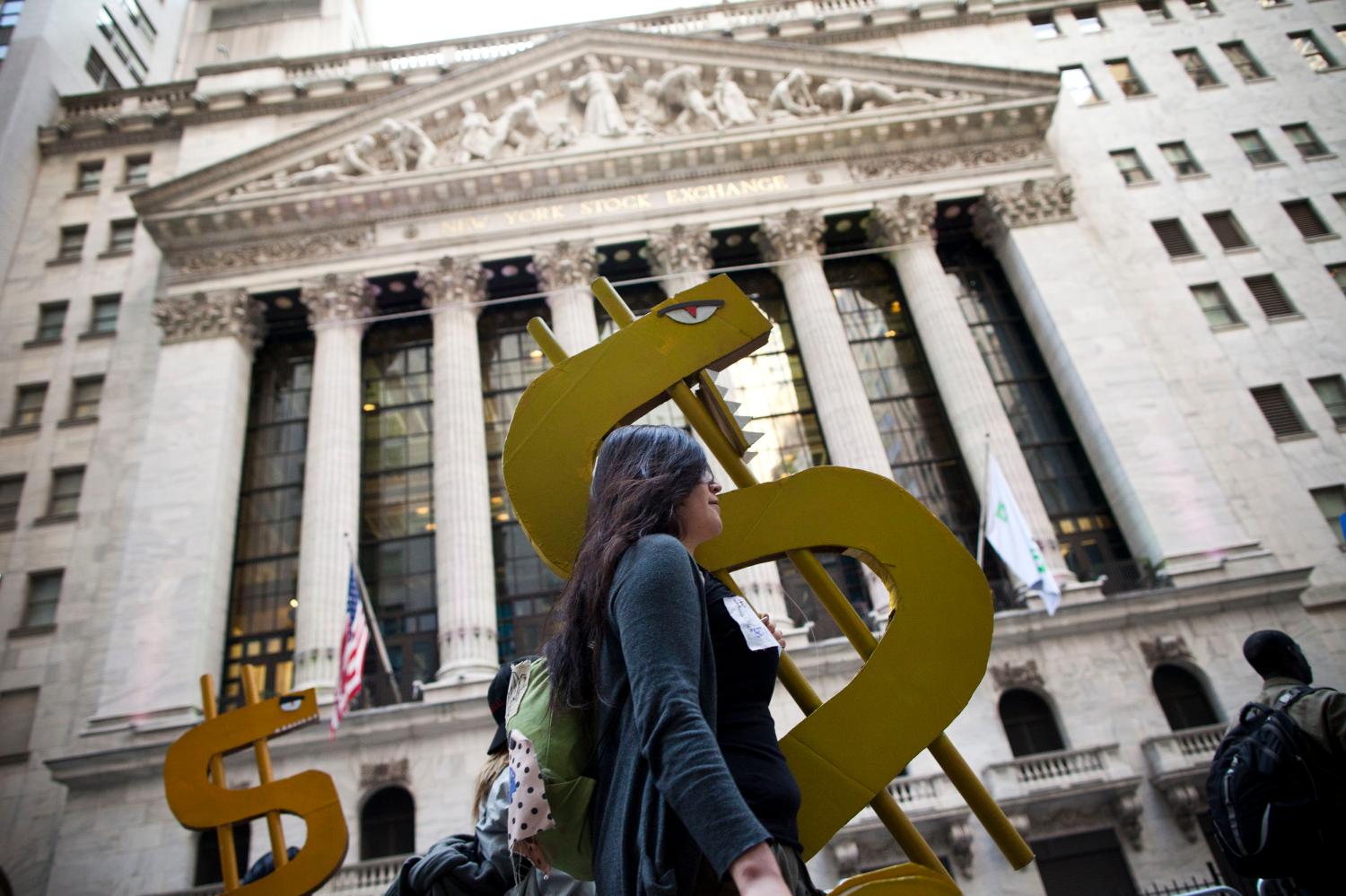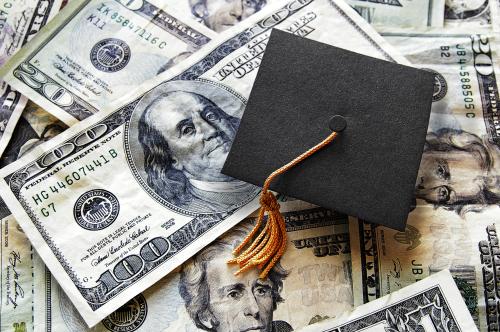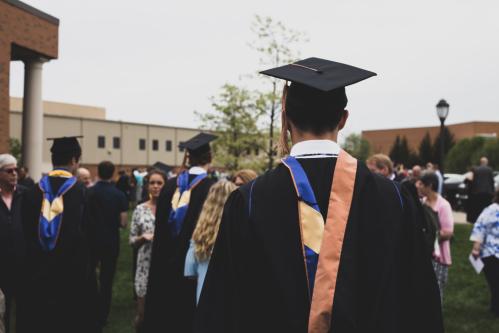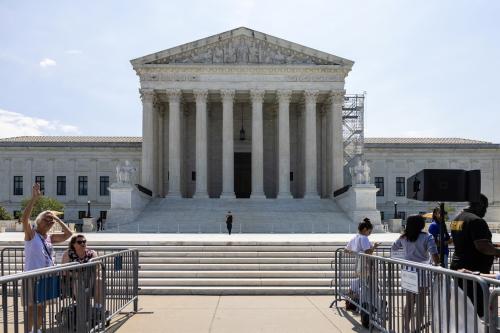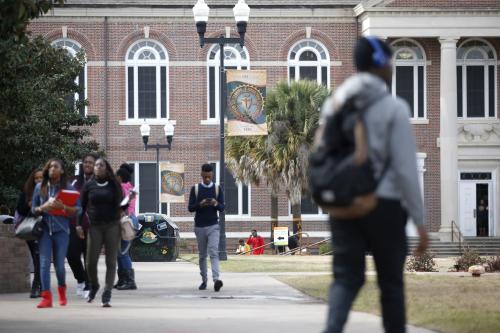This report is part of the Series on Financial Markets and Regulation and was produced by the Brookings Center on Regulation and Markets.
The CARES Act provided important temporary relief for student loan borrowers, permitting many with federally held debt to skip payments for 6 months, with borrowers generally given credit towards forgiveness for those payments. The legislation halted collections, though a significant number of borrowers were excluded.[1] However, given the severity of the COVID-19 economic impacts, and the dire circumstances for many student loan borrowers, more comprehensive and long-term student debt relief is required to enable these families to recover.
The limited student debt relief provided by the CARES Act is helpful, but briefly suspending payments for some borrowers, while providing no long-term solution, implies that once this national emergency is “officially” over, student loan borrowers will quickly return to stability. This is more than unrealistic. It actively disregards the overwhelming evidence that the student debt crisis was already at a tipping point and will be pushed over the edge by this pandemic. After the Great Recession, college attendance increased, but public support for education declined, resulting in a steep increase in borrowing. Subsequent wage growth did not match this higher debt, despite the majority of post-Recession jobs requiring postsecondary credentials, resulting in many unaffordable loans. Even in the recent periods of record-low unemployment, many student borrowers have been unable to make their loan payments, and far greater numbers have been unable to pay down the balance of their student debt after several years in repayment. The most recent report from the Federal Reserve found that more than 1 in 7 student loan borrowers in repayment were more than 90 days delinquent or in deeper default on their payments. Almost half of all borrowers were simply treading water, meaning that they were technically current on their payments but were not paying down their balances over the previous quarter. Prior to the crisis, almost two-thirds of student borrowers were unable to pay down the principal or even all of the monthly interest on their loans, resulting in increasing debt balances.
Student loan distress is particularly acute for borrowers of color. Due to longstanding systemic inequities and discriminatory practices resulting in less family wealth, higher levels of borrowing, targeting by poor quality for-profit schools and reduced earnings in the labor market, many borrowers of color have more debt than their incomes can support. They are more likely to borrow, to borrow in greater amounts, and to struggle in repayment. Not surprisingly, given these factors, the student debt burden falls heaviest on Black borrowers. For Black borrowers who entered higher education in 2003–2004 as undergraduates, almost half were in default by 2016. This number was projected to increase in ensuing years even before the current crisis hit. Half of all families with Black heads of household aged 25–40 have student debt, and 85% of Black graduates in 2016 took on debt to finance their undergraduate degree. Latino borrowers are also more likely than their white peers to fall behind on their loans, with nearly 3 in 10 already in serious delinquency with 15% of those in repayment in deep default. Women also struggle disproportionately and tend to have higher balances than their male counterparts, with the highest debt burdens of all falling on women of color.
The ranks of those already struggling with unaffordable student debt will be swelled by those who were just treading water pre-crisis and by the additional borrowers thrown into distress by the crisis. The economic pain of the COVID-19 pandemic is already historic, and forecasts predict it will persist. For example, the Congressional Budget Office projects unemployment still at 9% plus at the end of 2021. While others predict a quicker recovery, most projections include unemployment and other distress at substantially elevated levels deep into next year. Families will continue to struggle, and many with student debt will be among these. Given that many of these same families, and especially those of color, never recovered from the Great Recession, much more relief will be required to prevent this crisis from leaving millions of student debt borrowers with no path forward.
A number of student debt relief proposals have been made both during and since the CARES Act negotiations. During the CARES Act negotiations, a group of Senators including Patty Murray (D-WA), Sherrod Brown (D-OH), and Dick Durbin (D-IL), called for further relief of at least $10,000 of total reduction in student borrower debt. Many groups have called for larger levels of debt reduction, ranging from at least $20,000 to complete debt cancellation. Congresswoman Ayanna Pressley (D-MA) called for a minimum of at least $30,000 of forgiveness. A bipartisan duo in Congress proposed the Opportunities for Heroes Act in May 2020, which would provide cancellation of $25,000 in student loan debt (or an equivalent credit of $25,000 for future education) for a broad group of essential employees during the COVID-19 crisis, including medical staff, grocery store workers, and others. Former Vice-President Joe Biden endorsed the $10,000 of relief during the CARES Act negotiations and has subsequently called for broad student debt cancellation and increased prospective aid for new students. These proposals reflect strong bipartisan public support for a robust federal response to address the student debt crisis.
More recently, House Democrats passed the HEROES Act. The bill would extend the current payment suspension, interest waivers, and the involuntary collection halt from CARES to all federal student loan borrowers through September 2021. It also provides further relief in the form of $10,000 of cancellation for some federal and private student loan borrowers. However, this relief is limited to borrowers who qualify under an arbitrary test of “economically distressed.”[2] Based on the current provisions, a high earner who was laid off and receiving an unemployment deferral prior to March 12, 2020 may receive forgiveness, but a community college graduate working as an essential nursing assistant paying $25 per month under an income based repayment plan may not. Relief proposals must recognize that many borrowers who are employed and current on their loans are still experiencing significant financial hardship, particularly when states are forcing low- to moderate-income borrowers back to work despite unsafe conditions. In addition to the equity issues, there is considerable doubt as to whether this plan could be implemented effectively. The Department of Education’s student loan servicers have demonstrated an ongoing inability to implement even simple student loan programs, with many resulting errors.[3] Any effort to cancel student debt should take this into account and be effective and as simple as possible. Debt cancellation at a specified level for all borrowers will achieve this.
The impact of student debt cancellation would be surprisingly large, and the positive effects would reverberate throughout the economy. Beyond the individual impact of the student debt crisis, the adverse macroeconomic effects are widespread and well documented. Federal Reserve Chairman Jay Powell has, for several years, noted the adverse impacts on economic growth and called for student debt reform, including bankruptcy relief. In a recent analysis of the economic and fiscal impact of complete student loan cancellation (federal and private), and using conservative assumptions, researchers at the Levy Economics Institute simulated significant positive economic benefits in the form of increased GDP from increased household consumption and investment in the range of $86 billion to $108 billion per year over a 10-year period. Additionally, there would be significant social benefits from student loan cancellation, which studies have shown include increased family formation and stability, ability to pursue additional training, improved physical and mental health, increased entrepreneurial activity, and more.
Figure 1[4] shows the distribution of outstanding debt and the impact of different levels of debt cancellation. It reveals that almost 30% of borrowers have total student loan balances below $10,000, nearly half have balances under $20,000, and 6 in 10 student loan borrowers owe less than $30,000. Debt cancellation at $30,000, $20,000 and even $10,000 would profoundly reduce or eliminate their student debt. Furthermore, these Federal Reserve survey numbers likely understate the number and share of borrowers at each level who would benefit, because the data source does not include borrowers who are currently in school, borrowers who used student loans to pay for someone else’s education (e.g. Parent PLUS borrowers), or borrowers who did not know their loan amount. Indeed, an analysis using a different data source by the Center for Responsible Lending found that as many as 40% of all borrowers would experience complete cancellation if even $10,000 were forgiven. It would completely cancel the debt of 61% of the borrowers who are currently in default, most of whom have incomes that fall below or just above the federal poverty level for a family of three, which in 2019 was $21,330. Thus, this relief would provide desperately needed support and enable these families to recover and more fully participate in the economy, creating a broad boost that benefits all.

Some argue that universal debt cancellation is highly regressive and not equitable, however full analysis shows that it is fair and effective. Regression and equity analyses that only look to income ignore the substantial impact that historic family and individual wealth have on student debt accumulation and capacity to repay. Further, the myth of the high-debt, high-income borrower who will receive outsized benefits from debt cancellation proposals is belied by the fact fewer than 6% of borrowers have balances over $100,000. Almost 65% of borrowers have balances less than $25,000. In addition, this crisis has changed the make-up of distressed borrowers as layoffs spread to more and more industries and sectors, bringing additional individuals with substantial student debt into distress. Debt reduction will provide needed relief and disproportionately benefit struggling borrowers and borrowers of color.
In conclusion, the COVID-19 pandemic severely exacerbates an already bleak student loan outlook and compels action to prevent the burden of unaffordable student debt from thwarting the futures of tens of millions of American families and the overall economic recovery. Substantial, universally applied student debt cancellation is essential and effective, and it is needed now.
The authors did not receive financial support from any firm or person for this article or from any firm or person with a financial or political interest in this article. They are currently not an officer, director, or board member of any organization with an interest in this article.


